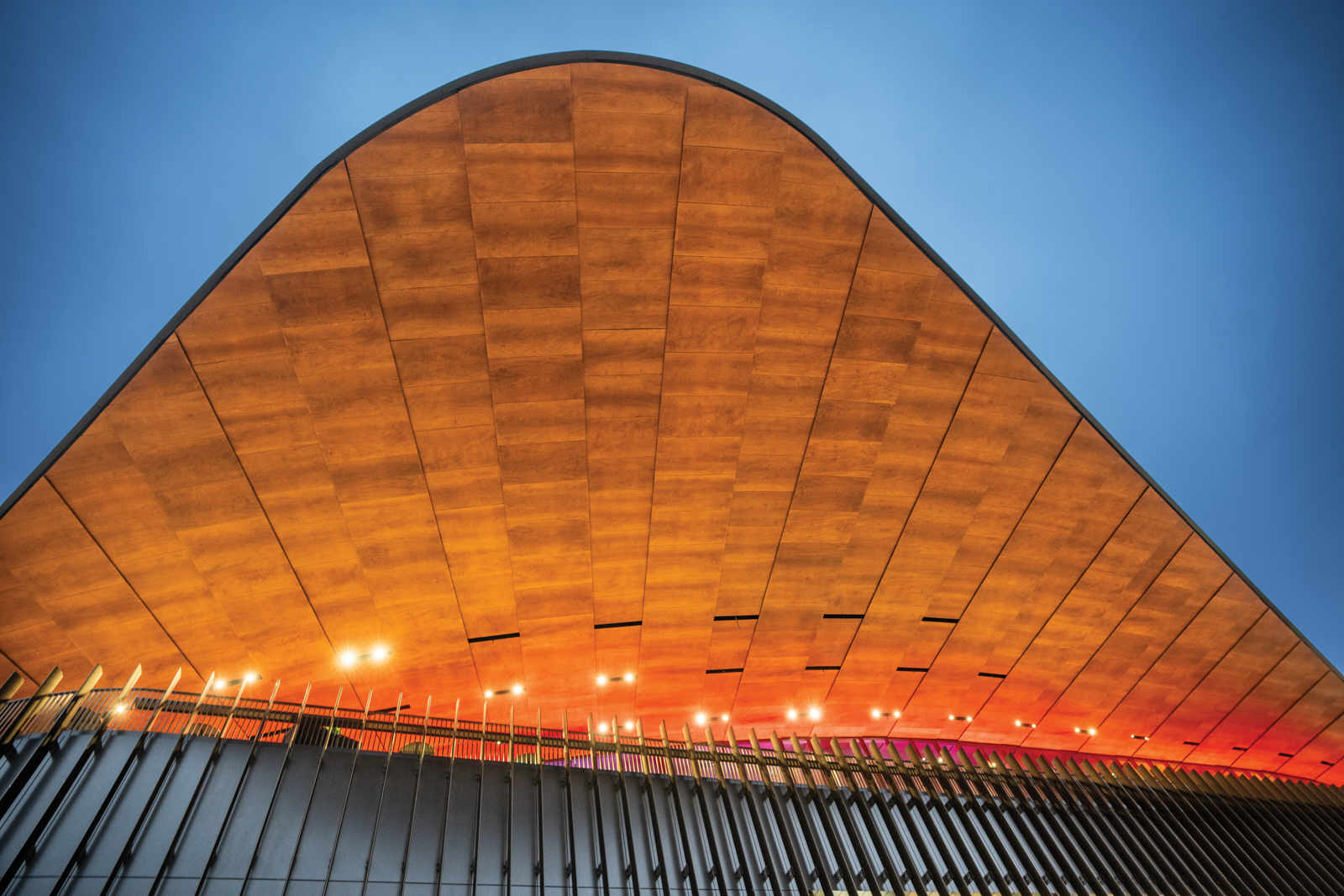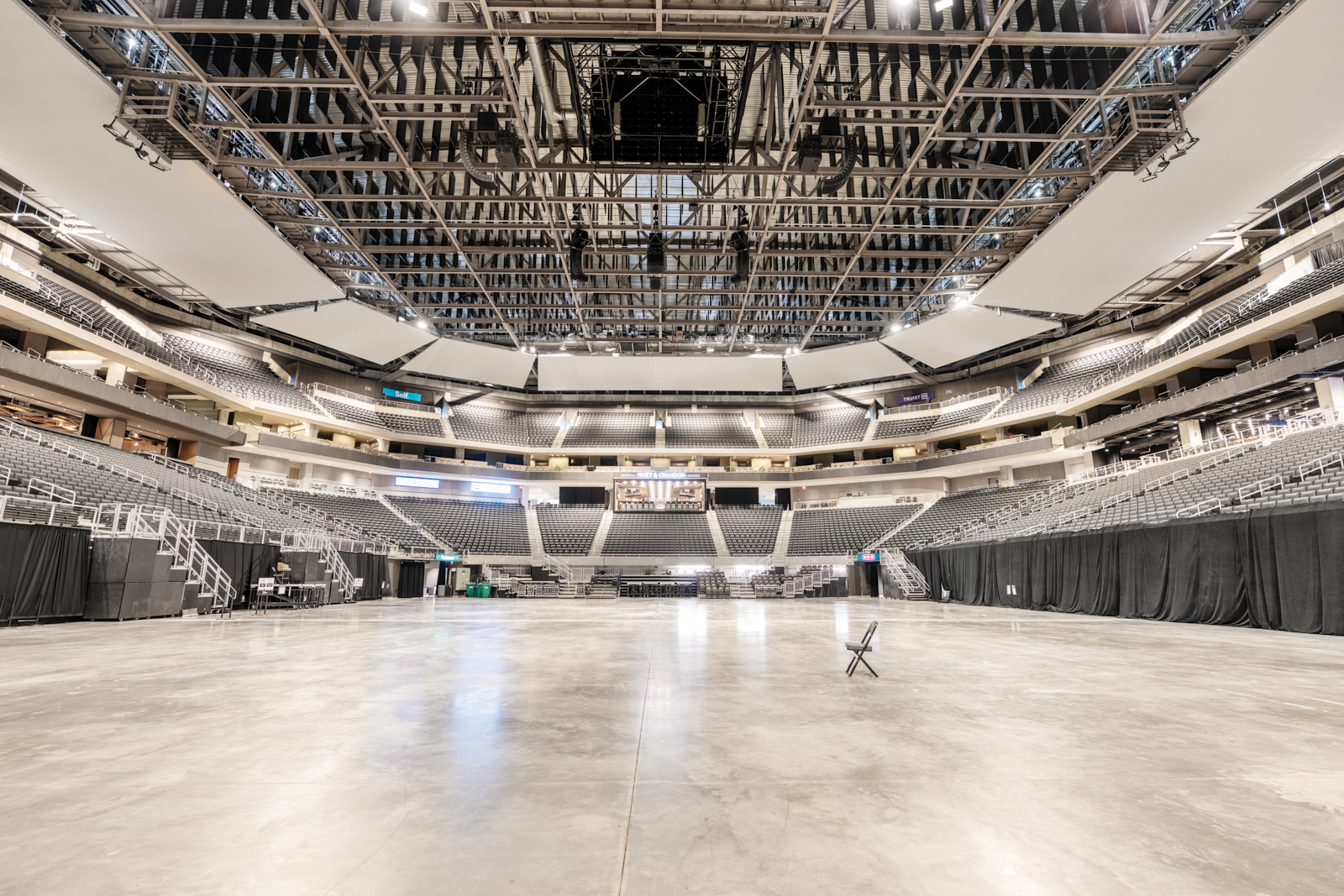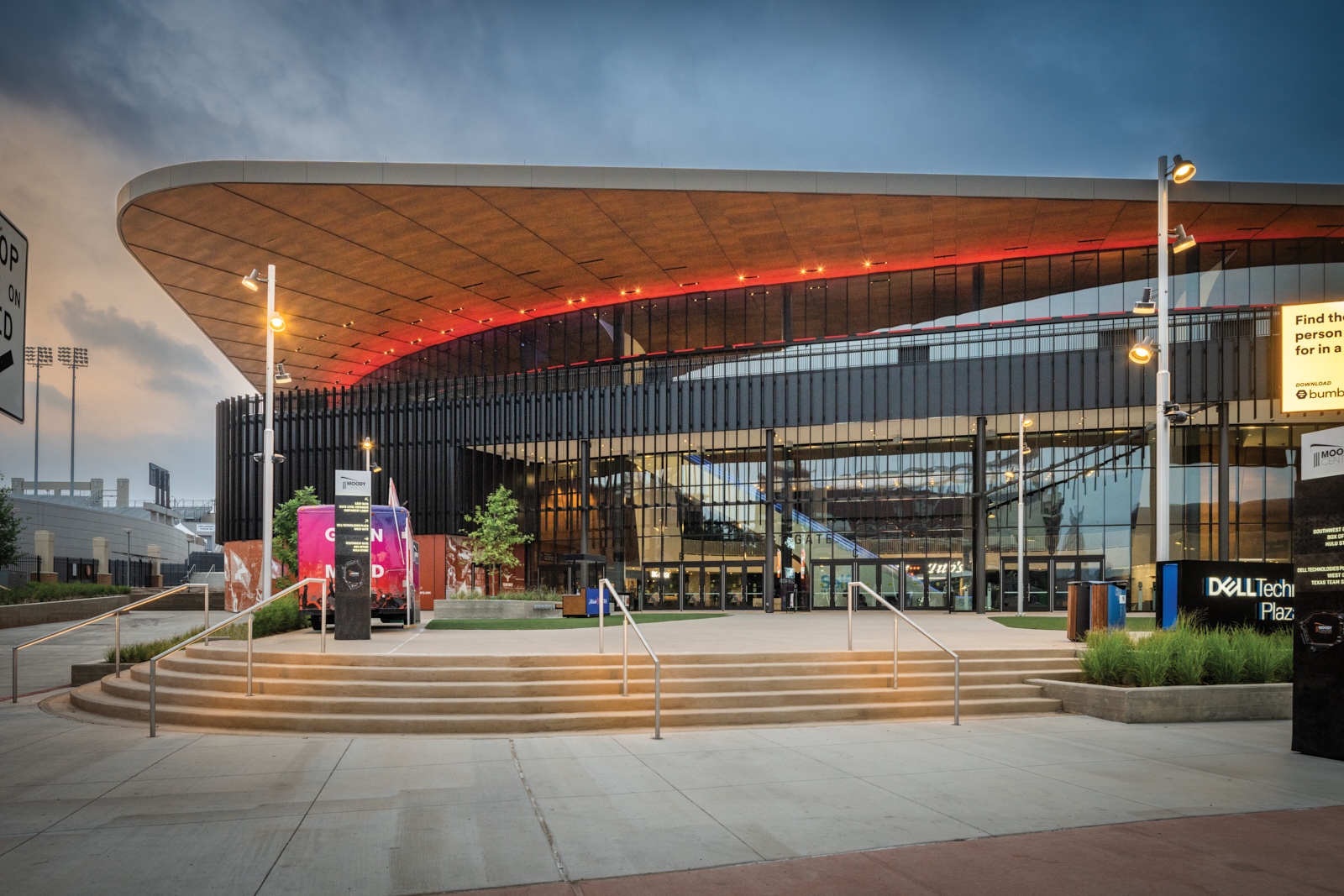Bless the Mood

At the Moody Center’s ribbon-cutting ceremony in April, Matthew McConaughey, duly dressed in a white-trimmed burnt-orange suit and cowboy hat, sang a strange original song he called “Bless The Mood,” while Vice President and Director of Athletics Chris Del Conte, Men’s Basketball Head Coach Chris Beard, Women’s Basketball Head Coach Vic Schaefer, and other members of the athletics staff watched on, amused. “We’ve got to bless the Mood with soul, yes it is time to bless the Mood,” he chanted. McConaughey tried entreating the crowd to join him in “blessing the Mood,” but most declined the opportunity to sing along. He ended his speech with a call to bring the memories made in the Erwin Center to the Moody Center and make new ones together as a community.
It was the Tuesday after Thanksgiving in 1977 the first time a ball was dribbled onto the slick new basketball court at the Frank Erwin Center. Rubber-soled shoes could be heard squeaking on the fresh hardwood at what was then simply called the Special Events Center, and colloquially known as “UT’s Astrodome.” In a game against the University of Oklahoma, Coach Abe Lemons led the men’s team to an 83-76 win, a fitting inauguration of the $34-million arena. The roar of the crowd was likely louder than it had ever been: previous games held at the Gregory Gymnasium sat far fewer fans. That season, the Longhorns would go on to win the National Invitation Tournament. A few months later, the Erwin Center hosted its first-ever concert (and first-ever sellout)—the accordionist and bandleader Lawrence Welk—followed by the Harlem Globetrotters, Ice Capades, and the John Denver Show, all within its first year of use.

Over the past 45 years, the venue has held world-class events and bore witness to great moments in history. An October 1992 Garth Brooks show sold out in 47 minutes, a venue record. The likes of Lady Gaga touring Joanne in 2017 in her Norma Kamali-designed Clifford-red puffy coat, Cher in 2002 descending in a cage, draped in a white fur-trimmed sparkling Narnia-esque mantle and bedazzled crown, and Earth, Wind & Fire in their bright, light-catching suits, vests, and puffy pantaloons on a 1994 tour—have all graced the Erwin Center stage with their iconic performances and unforgettable fashion statements. As a young man, Bruce Springsteen crowd surfed through a sea of Austin revelers while touring Darkness on the Edge of Town. Back in those days, fans had to show up in person to queue for tickets; for big names, the wait could be so long that people would hold students’ places in line so they could attend class and return.
Sometimes called “the Drum” or “the Super Drum,” the building has been a special part of both UT and the city of Austin’s history ever since its construction and will be missed by many students, fans, and residents who said their goodbyes when it closed its doors for good in May, to be eventually erased, possibly by implosion. The land the Erwin Center sits on along Red River Street was needed for the phase two expansion of Dell Medical School. So the home of the UT men’s and women’s basketball teams since its inception played host to the very last Longhorns game on its court on March 20, a 78-56 victory against Utah in the second round of the NCAA women’s tournament—a bittersweet affair.
Schaefer woke up with a sense of peace the morning of that final game. In a press conference following the win, he told reporters, “Our crowd today, to do it out there in the last athletic event in this great arena, to send this arena out that way, it was really, really cool. Really special.”
Reflecting on that final game, freshman guard Rori Harmon—who ended up being named 2022 Big 12 Freshman of the Year—acknowledged that while she only played at the Erwin Center for one year, “It was definitely an honor to play here.” She continued, “I just love our fan base. It gets so loud in there and really hot when a lot of people are there. But man, I was honored to play there, and I’m ready for the Moody Center.”
On Feb. 28, when the men’s team played their final game against Baylor (a 68-61 loss), former players returned to celebrate the last hurrah; former Texas point guard T.J. Ford, BS ’17, fired the T-shirt cannon; the Cooley family showed up. The seats were packed like they hadn’t been in years. Home game attendance had previously been on a middling streak, despite the efforts Beard has made in his first year at the helm to improve the fan experience and create a home-court advantage.
After the game, Beard joked with reporters that he’d wanted to make it a “Wrench Night,” allowing fans to disassemble the arena seats and take them home so they could keep a little piece of the Erwin Center with them forever.

Replacing the Super Drum and the decades of memories that were built there is the all-new, $375-million Moody Center—said to be one of, if not the most expensive college sports arena in the country—located on the northeastern side of campus on Robert Dedman Drive. Designed by Gensler and named after a $130 million grant from Moody Foundation, the arena opened to the public this April. Six or so years in the making, the venue marks the beginning of a fresh chapter in Longhorn history, and for the entire city of Austin. Its large wooden canopy, arguably its most eye-catching architectural feature, can be seen from the highway, giving the arena instant recognition, one of those buildings you know on sight due to some singular characteristic, like the Sydney Opera House’s tiered swoops or the Guggenheim Museum’s cake-like rotunda.
Gensler’s design director, John Houser, who had his high school graduation at the Erwin Center in 2001, says the holistic, collaborative approach to the Moody Center’s creation is what he’s most proud of. A large part of that collaboration involved working with Minister of Culture Matthew McConaughey, BS ’93, Life Member, Distinguished Alumnus, who will keep the center true to its mission. He was insistent that there be something for everyone at the arena, because Austin “is not a velvet rope city.” That request led to the unique lobbies and access points Moody houses on every level of the arena.

It’s not just a figurehead or vanity position. McConaughey has been integral to the design process, Houser says, “an advocate for the Austin culture within the building.” McConaughey and Houser’s team had many conversations about what makes Austin and The University of Texas special. “The design team did a really incredible job kind of incorporating these conversations into the final realization of the building,” Houser says. “Matthew is a person who deeply cares about our communities … Clearly, he is a big advocate for our people here. And I think that shows in his involvement in the project.” Moody was built adjacent to the football stadium on what was previously a parking lot, as well as segments of Red River, because the lot itself wasn’t large enough for an arena of its scale. Every detail was thoughtfully considered, down to the heritage old-growth oak trees in the parking lot that were lifted from the site and onto a hill until it was time to replant them at Moody’s front entrance. “Being able to protect those old trees that have been here a lot longer than we have and will be here a lot longer than we will be—it was really important,” Houser says. “It creates the sense of establishment and anchors the building into campus and makes it feel like it’s always been there.” In a sense, the transplanted trees close a historical loop; the Erwin Center’s complicated namesake once oversaw the arrest of students who protested the cutting down of trees along Waller Creek to expand the football stadium.
Houser and his team, along with McConaughey, set out to create a cultural icon directly connected to the city and to the campus, both accessibly and visually. The Erwin Center was seen as some kind of mausoleum of a building that had no connection to Austin. Houser puts it this way: “We always said, ‘Paul McCartney could be playing in the Center or it could be a huge critical basketball game, and you really wouldn’t know if you walked by or drove by the Erwin Center.’” Inside, you could be anywhere in the world, because the arena had no visual connection to its home. So that became the Moody Center’s driving concept early on—constant reminders of Austin’s and UT’s culture inside the building.

The concourse, with its 360-degree glass curtain wall, gives constant viewpoints of the city, including the downtown skyline, the Capitol building, and the UT Tower. “And then when you drive by and you see concerts,
or a basketball game, you’ll see the people moving through the concourse, you’ll see that energy, and it’ll be a reminder about how exciting it is to live in our city and go to The University of Texas, because you’ll just see all these people coming together for these different events,” Houser says.
The 70,000-square-foot wooden canopy provides ample natural light—its exterior more or less becomes the ceiling and wall inside the building has a dual function as a shading device, contributing to the building’s energy efficiency and sustainability goals. The wood canopy offers shade to the wraparound terrace, and allows ambient daylight to filter into the building, while minimizing interior heat gain.
Inside the 530,000-square-foot space is a sprawling wonderland, outfitted with neon designs and original murals painted by local artists, such as Will Hatch Crosby’s “Ambassador of Weird,” a Longhorn creature relaxing against a tree, welcoming guests as they enter the main concourse on the east side of the building, and Ryan Runcie’s “Rockin’ Horns,” an aura and chakra-colored “hook ’em horns” hand that’s grasping two drumsticks. There are plans to potentially turn the western plaza into a beer garden Longhorn football fans can visit on their way to the Darrell K Royal-Texas Memorial Stadium.
First there was Bevo Boulevard for football, now a gargantuan cultural institution and basketball palace all in one. What will all these new bells and whistles mean for Longhorn fans? According to Houser, every single aspect of the new arena was built with them in mind.
The design team wanted every fan—from private box seat ticket holders or super-VIP Moët & Chandon Impérial loungegoers to those seated in the bargain back-row spots—to have a top-notch experience. The student section wraps around the court; the seats directly behind them are lifted up so no views are obstructed. The ceiling can be lowered to create a more intimate experience, for basketball games, for instance, or expanded for giant, arena shows—as it will be in July for Kendrick Lamar’s Big Steppers Tour—to increase capacity by about 16 percent. The AC flows from the ground up—what’s called a positive displacement ventilation system in HVAC parlance—instead of the more common top to bottom method, which is less efficient. Almost every seat has cooling air coming directly to it from vents below.
Del Conte believes the Moody Center will give UT a home-field advantage that it didn’t necessarily have in its previous digs because of how close the new student section is to the court. At the Erwin Center, the student section was scattered throughout the arena; now it will be consolidated. “Creating that tight-knit fan base, and then being able to recede the entire stadium and put our students on the floor? This is a big boon for us, to all of our students,” he says. “The student section will be on the floor, 270 degrees around the court. Think about that.”
What’s particularly unique about the Moody Center is its public-private partnership between the university, McConaughey, sports and entertainment company Oak View Group (OVG), and Live Nation/C3 Presents. The University of Texas owns the land that Moody was built on, and OVG will fund and manage the venue on most nights for the next three decades or so. Meanwhile, UT has the run of the house around 60 nights per year for men’s and women’s basketball games as well as other events. The aspiration is to attract the best and biggest music acts in the world—Beyoncé level. According to Billboard, Justin Bieber has already praised the Moody’s acoustics, a feather in the brand new venue’s chapeau. The public-private partnership model is a relatively new approach in collegiate sports facility design, one that other universities are sure to watch closely.

Fans will carry over memories of watching legendary Women’s Basketball Coach Jody Conradt lead the Longhorns to their 800th victory under her tutelage in January 2003, and the deafening roar of the crowd when elite scorer Travis Mays regularly scored into the three digits during his early ’90s collegiate career. One UT professor shared with KXAN his memories of spending an entire day inside the arena auditioning and making the Wheel of Fortune college championship team in 1993 and winning $50,000. Some longtime employees of the Erwin Center, like Senior Associate Athletics Director Jimmy Earl and Associate Director Liz Land—though the former retired in 2020, and Land won’t be making the transition to the new facility—will cherish their memories of meeting Oprah, Dolly Parton, Elton John, and Michelle Obama. On one occasion, they gave Jon Bon Jovi a Longhorns football jersey, and he wore it on stage. At the end of the day, the Moody Center is just another building, albeit a mighty impressive one, with bones of steel and finely crafted wood, built and designed with utmost care. Perhaps decades into the future, it too will be shuttered and replaced with some new majesty, though the folks behind the project are hoping it will be more like a half-century at least. What will make the place special is the people who gather there: the fans, the students, the Austinites.
CREDITS: Jeff Wilson





